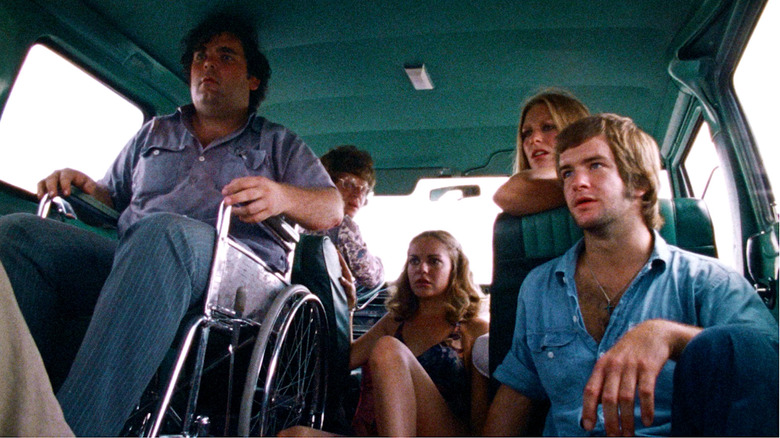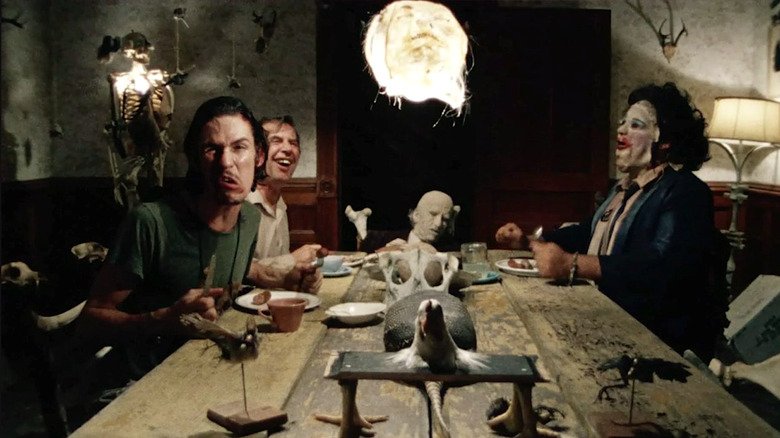Tobe Hooper Made The Texas Chain Saw Massacre Because Horror Movies Were 'Boring'
The thing about being a fan of horror movies is that the more of them you see the less scary they become. The mind starts to desensitize itself to the jump scares and the gore so that what might be downright terrifying to the uninitiated ends up being only mildly frightening to a super fan. Recently, "Terrifier 2," the sequel to Damien Leone's 2016 splatter film about the homicidal Art the Clown, has been making headlines for its decision to really Go There with its gore. There have been reports of people passing out in theaters, seemingly unable to stomach the horrors on screen, and even horror fans with the strongest of stomachs have commented on the extreme brutality of this new film. Over the years, many horror films have disturbed audiences in similar, visceral ways, but only one paved the way for the future of gore: Tobe Hooper's 1974 masterpiece, "The Texas Chain Saw Massacre."
Now largely considered to be one of horror's most demented and frightening gems, "The Texas Chain Saw Massacre" caused a split reaction in its audiences when it was first released. Some people loved the sheer brutality, while others couldn't make it through the whole thing. The late Gunnar Hansen who plays Leatherface in the original film detailed audience's extreme reactions to "Chain Saw" in his book "Chain Saw Confidential." "I remember the screams in the theater," he recalls. "People walked out. But the audience that stayed was hooked."
Today, "Chain Saw" is celebrated amongst critics (New York's Museum of Modern Art has a copy of the film in its archives) for its ability to evoke overwhelming feelings of unease as well as provide smart commentary on the political climate of the 70s. But just what was Hooper's inspiration for making such a disturbing and polarizing film at the time? It turns out a large motivation for Hooper was simply just boredom.
A whole new kind of horror
"The Texas Chain Saw Massacre" tells the story of a group of young friends driving across Nixon's America who unexpectedly find themselves running for their lives from the demented hands — and chainsaw — of a depraved family of psychopaths looking to kill them off one by one. It's a disturbing and unrelenting exploration of madness that has a knack for really getting under your skin.
In an interview with NPR's Terry Gross, Tobe Hooper — who passed away in 2017 — explained his motivations behind making a film that still manages to be just as disturbing now as it was nearly 50 years ago. "I don't think I set out to change the genre consciously," he said, going on to say that he "simply made a film that [he] wanted to see." For Hooper, the horror scene "had gotten [...] very boring and totally unscary (ph) and hokey and bad." He told Gross, "I wanted to make something that worked again, that had chair jumpers in it, you know, that moved an audience. So I really set out as a fan of the genre to do something that gave you [...] your money's worth."
Hooper may not have consciously meant to make a film that completely redefined the boundaries of what a horror film could do, but his impulse to entertain himself ultimately ended up influencing entire generations of future filmmakers with its gritty atmosphere and overwhelming sense of dread. There will always be those looking to out shock the latest and greatest in gore, but Hooper and "Chain Saw" will always be known as the film that went there first.

